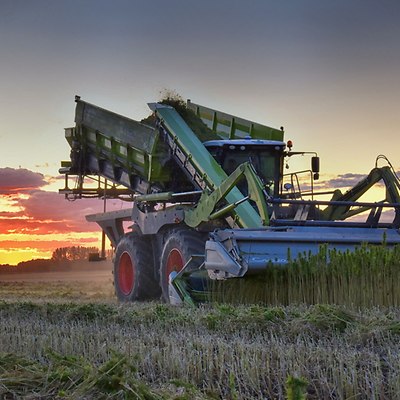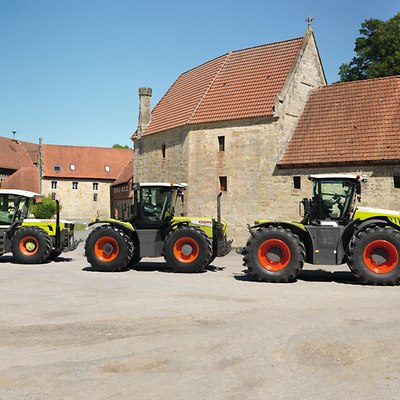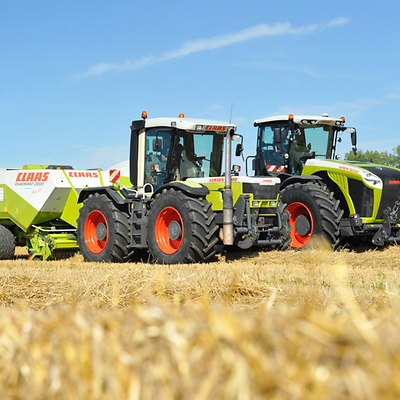

It was a long journey.
After almost 20 years of development, the first generation XERION appeared in 1997. CLAAS archivist and company historian Tomislav Novoselac explains why it took so long to reach market readiness and which core features the system tractor has retained to this day.
So what prompted CLAAS – the harvesting specialist – to build a tractor?
There were a number of factors involved. For a start, the tractor is the most important machine on the farm, because it forms the basis for so many activities – from tillage and drilling to various tasks around the yard. So for CLAAS, being able to offer our own tractor was an enticing prospect. Then in the nineties economic necessities came into play, as dealer networks increasingly focussed on suppliers who could offer a full product range. Agricultural machinery manufacturers without tractors struggled in this environment. And last but not least, producing our own tractor was a long-held dream of August Claas and his son Helmut Claas – a dream they pursued for several decades.
Why was the project so important to them both?
Helmut Claas in particular was convinced that a multi-functional tractor could make farming more economical. As he saw it, the most expensive component of an agricultural machine is the drive train. He thought it would be very efficient if you could use a farm tractor with different attachments to perform a variety of tasks around the farm. At the same time, an exceptionally versatile and powerful tractor with over 200 hp was such an unusual concept that we would stand out from the competition in the tractor market.

What were the forerunners to the XERION?
The HUCKEPACK launched in 1957 was in a sense the forefather of the XERION. This vehicle was an implement carrier which could be used for a variety of tasks such as tillage, drilling and even mowing. But the unique selling point of the HUCKEPACK was that it could be converted to a combine harvester. However, due to technical difficulties it remained in production only until 1960. Then came the HSG (its name is the German acronym for hydrostatic transmission). It was a prototype which CLAAS worked on from 1968 to 1972 to test the transmission to which it gave its name. This too was a multi-purpose vehicle with four equal-size wheels. Then in 1978 Project 207 was launched, which was later to become the XERION.
It would be almost another 20 years before the XERION first appeared.
Yes, it was a long journey. But for Helmut Claas it was essential for a tractor made by his company – unlike rival brands – to have a continuously variable transmission for greater comfort during field work. This was a totally novel concept at the time. So perhaps unsurprisingly, finding a suitable supplier proved difficult. CLAAS engineers tested several continuously variable transmissions, and even developed one themselves, before eventually finding a solution in the mid-nineties, and then the XERION was born.
How did farmers react to the first generation XERION?
It went down well with the selected customers who were the first to try out the XERION. But the first generation did have a few shortcomings. There were calls for more engine power and the continuously variable transmission did not work quite as we had hoped. So we installed a ZF transmission in the second generation, the XERION 3300 and 3800. These models were launched from 2003 along with the new standard tractors. Since then, the XERION has really grown in popularity.
The XERION has a large fan base and generates a great deal of interest in the industry. Was that the case from the start?
No. Its popularity gradually grew as it became clear that you could use the XERION for a host of different tasks. Then there was the machine's enormous size and power. This combination of power and versatility holds a fascination for many people still today.
How has the XERION evolved in the last 25 years?
It is now far more powerful and has much more electronic wizardry. The areas of application have shifted too. The XERION was originally conceived for use as a beet lifer, for instance, although that never really caught on. Nowadays the XERION is very popular for applications such as manure spreading and silage clamp work.
Have the old values of the XERION been retained though?
Yes, I would say so. All three core features of the XERION are still there. Today it is even more versatile than originally envisaged and is used for a wider range of applications, from snow clearing and blowing to wood chipping. What's more, the XERION still has a continuously variable transmission and remains a full-scale large tractor which can also perform traditional tasks such as plouging and cultivating.
How do you think the XERION will evolve in the future?
The performance will probably increase. Soil protection will become an increasingly important issue. I can well image that in future the system tractor will have even more crawler tracks. In addition, digital assistance systems are likely to play a greater role and new areas application may well emerge. But the core strengths of the XERION – its versatility and efficiency – will remain.











